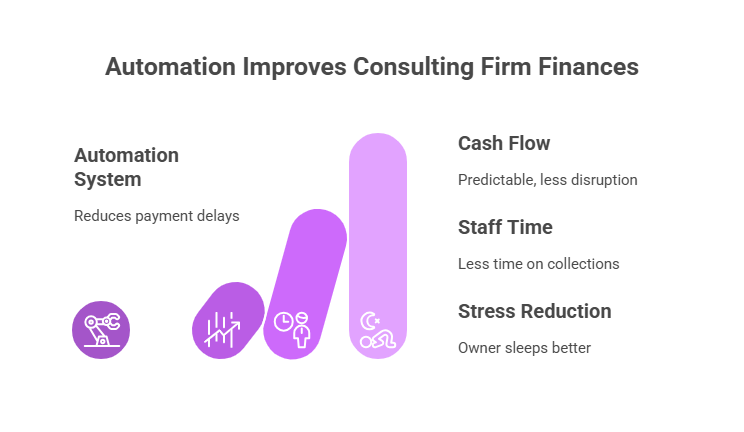
Last Tuesday, I watched my friend Jake crumple up yet another overdue notice from his biggest client. “Three months,” he muttered, tossing it toward the trash can. “Three months they’ve been sitting on this invoice.” As someone who’s built a small graphic design studio from the ground up, Jake knows every delayed payment isn’t just an inconvenience—it’s a direct hit to his ability to keep his team paid and his dreams alive.
This scene plays out in countless offices every day. Business owners wrestle with the same frustrating reality: great work done, invoices sent, and then… silence. The waiting game begins, and with it, a cascade of problems that most people never see coming.
The Real Price of Playing the Waiting Game
Here’s what nobody tells you about late payments when you’re starting out. It’s not just about the money that’s missing from your bank account. It’s about everything else that money was supposed to do.
Take Lisa, who runs a boutique marketing consultancy. When her biggest client finally paid their $25,000 invoice—45 days late—she didn’t just get her money back. She got a harsh lesson in opportunity cost. During those 45 days, she couldn’t invest in the new software her team needed. She couldn’t take on that promising new project because she didn’t have the cash flow to hire temporary help. She couldn’t even sleep properly, constantly worrying about making payroll.
The statistics are sobering, but they don’t capture the human element. Studies reveal that small businesses typically tie up nearly 20% of their revenue just managing who owes them what. Imagine if you could redirect that energy, that mental bandwidth, that pure stress into actually growing your business instead of chasing down payments.
But here’s the kicker—it’s not just about the money. It’s about the relationships. Every awkward phone call asking “Hey, just wondering about that invoice…” chips away at the professional rapport you’ve worked so hard to build. You start second-guessing yourself. Maybe I should have asked for payment upfront. Maybe I’m being too pushy. Maybe this is just how business works.
Spoiler alert: it doesn’t have to be.
When Technology Becomes Your Best Employee
Meet David, who discovered automation almost by accident. His accountant suggested trying an automated billing system “just to see what happens.” David was skeptical—he’d always prided himself on the personal touch, the handwritten thank-you notes, the direct relationships with his clients.
Six months later, David’s perspective had completely shifted. His clients weren’t getting annoyed by automated reminders; they were thanking him for them. “I totally forgot about this,” became a common response. The system wasn’t making things impersonal—it was making them professional.
The transformation went beyond just faster payments. David’s clients started commenting on how organized and efficient his business seemed. New prospects were impressed by the seamless payment process. His team could focus on delivering great work instead of tracking down money. The automation had become like hiring the world’s most reliable, never-tired administrative assistant.
Modern payment automation isn’t your grandfather’s billing system. We’re talking about smart technology that learns your clients’ payment patterns, predicts potential issues before they happen, and adapts to different industries and payment preferences. It’s like having a crystal ball for your cash flow, but one that actually works.
The Numbers That Changed Everything
Let me share some real numbers from a client I worked with last year. This isn’t theoretical—this is what actually happened to a 15-person consulting firm that decided to take the plunge.
Before automation, their monthly reality looked like this:
- 180 invoices sent out, average $3,200 each
- 30% arrived late (that’s 54 invoices)
- Average delay: 35 days
- Monthly cash flow disruption: $172,800
- Cost of that disruption at 9% annual rate: $1,382
- Staff time spent chasing payments: 25 hours ($1,500 in wages)
- Monthly headache factor: immeasurable
After six months with their new system:
- Late payments dropped to 12% (22 invoices)
- Average delay: 18 days
- Monthly cash flow disruption: $70,400
- Cost of disruption: $563
- Staff time on collections: 8 hours ($480)
- Monthly stress reduction: priceless
The math is simple: they saved $1,819 every month. The system paid for itself in less than two months. But the real victory? The owner told me he slept better at night knowing his cash flow was predictable and his team could focus on what they loved doing.

The Ripple Effect Nobody Talks About
What happened next surprised everyone. With steady cash flow, the company could negotiate better deals with suppliers. They offered clients more flexible payment terms, knowing their collection process was bulletproof. They took on bigger projects because they could predict their financial position weeks in advance.
The staff noticed too. When you’re not constantly worried about whether you can make payroll, you make better decisions. You invest in training. You take calculated risks. You say yes to opportunities that might have seemed too risky before.
For business owners like Jake, this represents something profound. It’s not just about efficiency or cost savings—it’s about reclaiming control over your business destiny. When cash flow becomes predictable, everything else becomes possible.
The companies thriving in today’s market aren’t necessarily the ones with the best products or services. They’re the ones that have figured out how to remove friction from their operations, create better experiences for their clients, and focus their human energy on what actually moves the needle.
Automation isn’t about replacing the human element in business—it’s about amplifying it. When the mundane tasks run themselves, people can focus on creativity, strategy, and building the relationships that truly matter.
The question isn’t whether automation will pay for itself. The question is: what will you do with all that extra time and energy once it does?
Send your sample invoice to info@valuedx.com — we’ll get back to you with the extracted data.
Read our next blog – Click here

